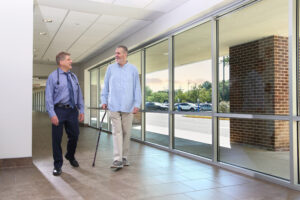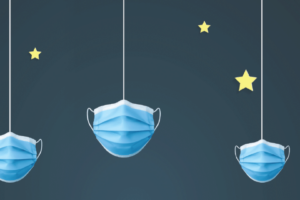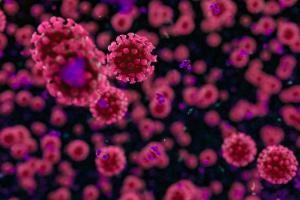After a positive COVID-19 test result, Gennaro Esposito did his best to rest and self-quarantine. But when a simple walk up the stairs of his home left him breathless, he called for an ambulance to take him to CentraState. With his oxygen levels dropping, doctors weighed whether to put Gennaro on a ventilator. The 47-year-old Marlboro resident begged them not to do so.
“I was afraid of being intubated,” Gennaro remembers. “I asked if there was anything else we could do.”
Intubation requires a patient to be sedated, and using the ventilator could have put Gennaro at risk for lung or vocal chord damage, or infections such as pneumonia. As an alternative, the CentraState respiratory team felt Gennaro was a good candidate for the bilevel positive airway pressure (BiPAP) helmet—an innovative option the hospital began exploring at the start of the COVID-19 pandemic.
Standard BiPAP has been used for years, but this new technique uses a helmet sealed tight around a patient’s head and pressurized with oxygen. This idea was initiated by board-certified pulmonary and critical care physician Nirav N. Shah, DO, and the respiratory team at CentraState in hopes of providing patients an alternative to the ventilator and allowing them to continue to communicate with staff. Gennaro was willing to try anything to avoid intubation.
“I looked like Buzz Lightyear,” he jokingly explains. A tube connected to the side of the helmet blew oxygen into the helmet to keep it inflated, and the respiratory staff encouraged Gennaro to take deep breaths to rebuild his lung strength. The helmet made it difficult to sleep soundly, but since he wasn’t sedated on a ventilator, Gennaro was able to stay alert and communicate with his wife on the phone. He wore the BiPAP continually for eight days.
“It was a slow process, but Gennaro was patient, and the helmet was incredibly effective for him,” says Dr. Shah. “Patients in a condition as severe as his usually need to be placed on a ventilator. But his spirit while wearing the helmet gave him the strength to persevere through the ups and downs of this disease.”
With his oxygen levels climbing, the respiratory team transitioned Gennaro to wear the BiPAP helmet only at night and use a high-flow nasal cannula and oxygen mask during the day. After a draining 26-day stay, Gennaro was discharged to continue his recovery at home with oxygen delivered via the nasal cannula. And while Gennaro praises the “amazing” respiratory and nursing team at CentraState who went “above and beyond” to treat him, he acknowledges that the BiPAP, uncomfortable as it was, may have saved him.
“It was a tough experience,” he says. “I just told myself I could do it, and I got through it.”
For more information about COVID-19 resources at CentraState, visit centrastate.com/covid-19





